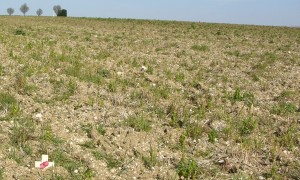
Battlefield on the Somme. (P. Ferguson image 2007)
I GOT HIT ON SEPTEMBER 24
Corporal Norman Caldwell (16th Battalion CEF) and his brother Harry Calldwell (67th Battalion CEF) were the nephews of Mr. L.A. Berkeley of Roccabella.
A portion of Norman’s letter entitled, Brothers Have Seen Some Heavy Fighting appeared in The Daily Colonist, 7 November 1916, page 10.
“I got hit on September 24…at about 4 o’clock in the afternoon, down in the Somme district, between Thiepval and Courcelette, where we had made an attack that day. I got through the charge all right and was dug in up on the ridge which we had taken from Fritz. We had been there only a few hours when a high explosion shell burst right on the edge of the trench where I was posted and buried me. The concussion at the same time tore a strip out of me about two or three inches wide, extending from about half way down the thigh on my right leg to about half way between the knee and ankle. The wound, however, was not very deep, and not at all serious. I was burnt a bit by the shell explosion as well, but my injuries are healing now.
I also got a few shrapnel cuts on the left shin, caused by the shell splinters, but they have only broken the skin, and all signs of them, I think, will be gone by another week.
I was buried for about fifteen minutes before I could be dug out. It seemed like a year while I was lying there, half smothered with earth and the weight on top of me.
Now that I think of it, I don’t think I ever told you that I was made corporal at the beginning of last July. If I hadn’t been wounded, I probably would have been sergeant by this time, as there were a few sergeants wounded whose places would have to be filled by senior corporals…”
In 1918 Caldwell was awarded the Military Medal for bravery in the field.
Tags: 16th Battalion CEF (Canadian Scottish), 1916, 24 September 1916, 67th Battalion CEF (Western Scots), Brothers, Courcelette, Harry Caldwell, Military Medal, Norman Caldwell, Somme, Thiepval, Wounded
This entry was posted by pferguson
on Saturday, September 24th, 2016 at 12:30 am and is filed under Snapshots of the Great War.
You can follow any responses to this entry through the RSS 2.0 feed.
You can leave a response, or trackback from your own site.
About The Author

Paul has worked with the Paradigm Motion Picture Company since 2009 as producer, historian and research specialist. Paul first met Casey and Ian WIlliams of Paradigm in April 2007 at Ieper (Ypres), Belgium when ceremonies were being held for the re-dedication of the Vimy Memorial, France.
Paul's sensitivity to film was developed at an early age seeing his first films at RCAF Zweibrucken, Germany and Sardinia. Paul returned to Canada in 1967 and was captivated by David Lean's "Lawrence of Arabia" and "Bridge on the River Kwai". Over time Paul became increasingly interested in storytelling, content development, character, direction, cinematography, narration and soundtracks.
At the University of Victoria, Paul studied and compared Japanese and Australian film and became interested in Australian film maker Peter Weir and his film "Gallipoli" (1981). Paul was inspired when he learned Weir visited the beaches, ridges and ravines of the peninsula. "Gallipoli", the film, led Paul on many journeys to sites of conflict in England, France, Belgium, Holland, Germany, Malta, Hawaii, Gallipoli, North Macedonia and Salonika.
When Paul first watched documentary filmmaker Ken Burns, "The Civil War", Paul understood how his own experience and insight could be effective and perhaps influential in film-making. Combining his knowledge of Museums and Archives, exhibitions and idea strategies with his film interests was a natural progression.
Paul thinks like a film-maker. His passion for history and storytelling brings to Paradigm an eye (and ear) to the keen and sensitive interests of; content development, the understanding of successful and relational use of collections, imagery and voice. Like Paul's favorite actor, Peter O'Toole, Paul believes in the adage “To deepen not broaden.”
While on this path Paul always remembers his grandmother whose father did not return from the Great War and how his loss shaped her life and how her experience continues to guide him.


Comments